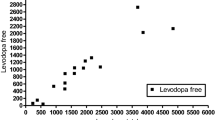Abstract
An assay technique for measuring anticholinergic drugs in human serum based upon their inhibition of the specific binding of [3H]-quinuclidinyl benzilate to rat brain muscarinic receptors is described. The assay was validated by demonstrating a close correlation (r=0.99) between serum levels of nortriptyline measured by the radioenzymatic assay and a GLC technique. The assay measures free anticholinergics, and under standard assay conditions, approximately 95% of benztropine is bound to serum protein. Marked variation in serum anticholinergic levels in patients receiving the same oral dose was observed, and in individual patients there was a non-linear relationship between increasing oral dose and serum anticholinergic levels.
In a cross-sectional study of 109 patients receiving concurrently neuroleptics and antichlinergics, there was no correlation (r=0.029) between serum neuroleptic levels measured by a radioreceptor assay and extrapyramidal side effects (EPS). In the patients whose serum anticholinergic levels were also determined, there was a significant inverse correlation (r=0.44) between anticholinergic levels and EPS. In this cohort of patients, there was no significant correlation between serum anticholinergic and serum neuroleptic levels (r=0.16) and the ratio of serum anticholinergic to serum neuroleptic was a poor predictor of EPS (r=0.26).
The results suggest a marked variation in sensitivity of patients to the EPS-inducing of neuroleptics; nevertheless, the incidence of EPS decreases with increasing serum levels of anticholinergics. An optimal serum anticholinergic level of 10 pmole atropine equivalent per ml was associated with a low incidence of EPS and is relevant to drug action at the striatal muscarinic receptor.
Similar content being viewed by others
References
Ahmed A, Marshall PB (1962) Relationship between anti-acetylcholine and anti-tremorine activity in anti-parkinsonian and related drugs. Br J Pharmacol 18:247–254
Alpert M, Diamond F, Weisenfreund J, Taleporos E, Friedhoff AJ (1978) The neuroleptic hypothesis: a study of the covariation of extrapyramidal and drug effects. Br J Psychiatry 133:169–175
Ayd FJ (1961) A survey of drug-induced extrapyramidal reactions. JAMA 175:1054–1060
Burt DR, Creese I, Snyder SH (1977) Antischizophrenic drugs: chronic treatment elevates dopamine receptor binding in brain. Science 196:326–328
Calne D, Chase TN, Barbeau A (eds) (1975) Dopaminergic mechanisms, vol 9. Raven Press, New York
Chase TN, Schnur JA, Gordon EK (1970) Cerebrospinal fluid monoamine catabolites in drug-induced extrapyramidal disorders. Neuropharmacology 9:265–268
Creese I, Snyder SH (1977) A simple and sensitive radio-receptor assay. Nature 270:261–263
Davis JM (1974) Dose equivalence of the antipsychotic drugs. J Psychiatr Res 11:65–69
DiMascio A (1976) A controlled trial of amatidine in drug induced extrapyramidal disorders. Arch Gen Psychiatry 33:599–602
Donlon PT, Stenson RL (1976) Neuroleptic-induced extrapyramidal symptoms. Dis Nerv Syst 37:629–635
Eadie MJJ, Tyrer JH (1974) Anticonvulsant therapy. Pharmacological basis and practice, Churchill Livingstone London pp 35–78
Freedman DX, DeJong J (1961) Factors that determine drug-induced akathisia. Dis Nerv Syst 22:69–76
Hansen LB, Elley J, Christensen TR, Larsen NE, Narstoft J, Hridberg EF (1979) Plasma levels of perphenazine and its major metabolites during simultaneous treatment with anticholinergics. Br J Clin Pharmacol 7:75–80
Inch TD, Brimblecome RW (1974) Antiacetylcholine drugs. Int Rev Neurobiol 16:67–144
Innis R, Tune L, Rock R, DePaulo JR, U'Prichard D, Snyder SH (1979) Tricyclic antidepressant radioreceptor assay. Eur J Pharmacol 58: 472–477
Jurgenson A (1975) A gas chromatographic method for determination of amitriptyline and nortriptyline in human serum. Acta Pharmacol Toxicol 36:79
Muller P, Seeman P (1978) Dopaminergic supersensitivity after neuroleptics: time course and specificity. Psychopharmacology 60:1–11
National Institute of Mental Health-Psychopharmacology Science Center Collaborative Study Group (1964) Phenothiazine treatment in acute schizophrenia: Effectiveness Arch Gen Psychiatry 10:246–261
Racagni G, Cheney DL, Trabucchi M, Costa E (1976) In vivo actions of clozapine and haloperidol on the turnover rate of acetylcholine in rat striatum. J Pharmacol Exp Ther 196:323–332
Rehavi M, Maayani S, Sokolovsky M (1977) Tricyclic antidepressants as antimuscarinc drugs: in vitro and in vivo studies. Biochem Pharmacol 26:1559–1567
Richelson E, Divinetz-Romero S (1977) Blockade by psychotropic drugs of the muscarinic receptor in cultured nerve cells. Biol Psychiatry 12:771–782
Rish SC, Hicey LY, Janowsky DS (1979) Plasma levels of tricyclic antidepressants and clinical efficacy. Review of the literature. J Clin Psychiatry 40:4–116
Sethy VH, Van Woert MH (1973) Antimuscarinic drugs — effect on brain acetylcholine and tremors in rats. Biochem Pharmacol 22:2685–2691
Snyder SH, Greenberg D, Yamamura HI (1974) Antischizophrenic drugs and brain cholinergic receptors. Arch Gen Psychiatry 31:58–61
Snyder SH, Yamamura HI (1977) Antidepressants and the muscarinic acetylcholine receptor. Arch Gen Psychiatry 34:236–239
Spitzer RL, Endicott J, Robins E, Kuriansky J, Gurland B (1975) Preliminary report of the reliability of reserach diagnostic criteria applied to psychiatric case records. In: Sudilovsky A, Gershon S, Beer B (eds). Predictability in psychopharmacology: preclinical and clinical correlations. Raven Press, New York, pp 1–30
Tune LE, Coyle JT (1980) Serum levels of anticholinergic drugs in treatment of acute extrapyramidal side effects. Arch Gen Psychiatry 37:293–297
Tune LE, Creese I, Coyle JT, Pearlson G, Snyder SH (1980a) How neuroleptic serum levels in patients receiving fluphenazine decanoate. Am J Psychiotry 137:80–82
Tune LE, Creese I, DePaulo JR, Slavney PR, Coyle JT, Snyder SH (1980b) Clinical state and serum neuroleptic levels measured by radioreceptor assay in schizophrenia. Am J Psychiatry 137:187–190
VanPutten T (1974) Why do schizophrenic patients refuse to take their drug? Arch Gen Psychiatry 31:67–72
Yamamura HI, Snyder SH (1974) Muscarinic cholinergic receptor binding in the longitudinal muscle of the guinea pig ileum with [3H] quinuclidinyl benzilate. Mol Pharmacol 10:861–867
Author information
Authors and Affiliations
Rights and permissions
About this article
Cite this article
Tune, L., Coyle, J.T. Acute extrapyramidal side effects: Serum levels of neuroleptics and anticholinergics. Psychopharmacology 75, 9–15 (1981). https://doi.org/10.1007/BF00433493
Received:
Accepted:
Issue Date:
DOI: https://doi.org/10.1007/BF00433493



